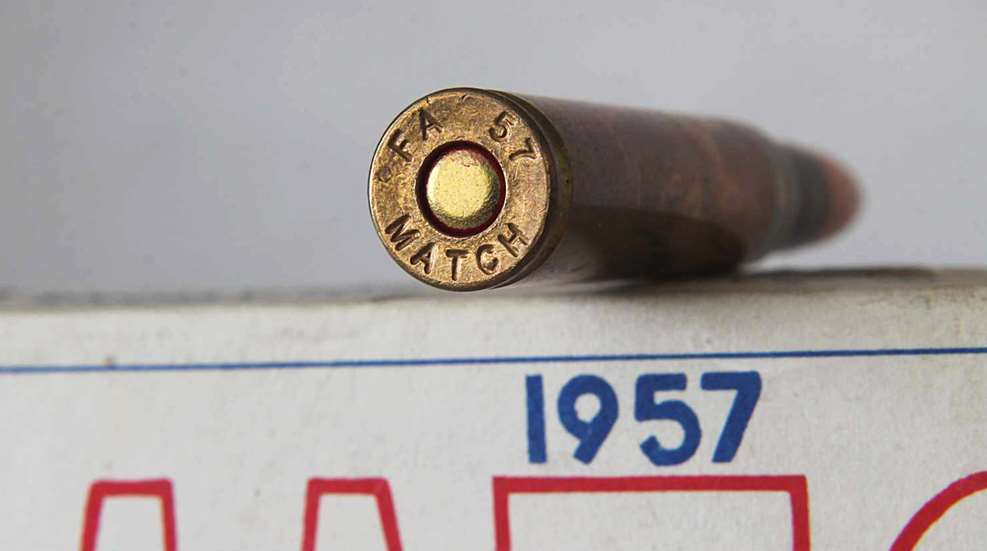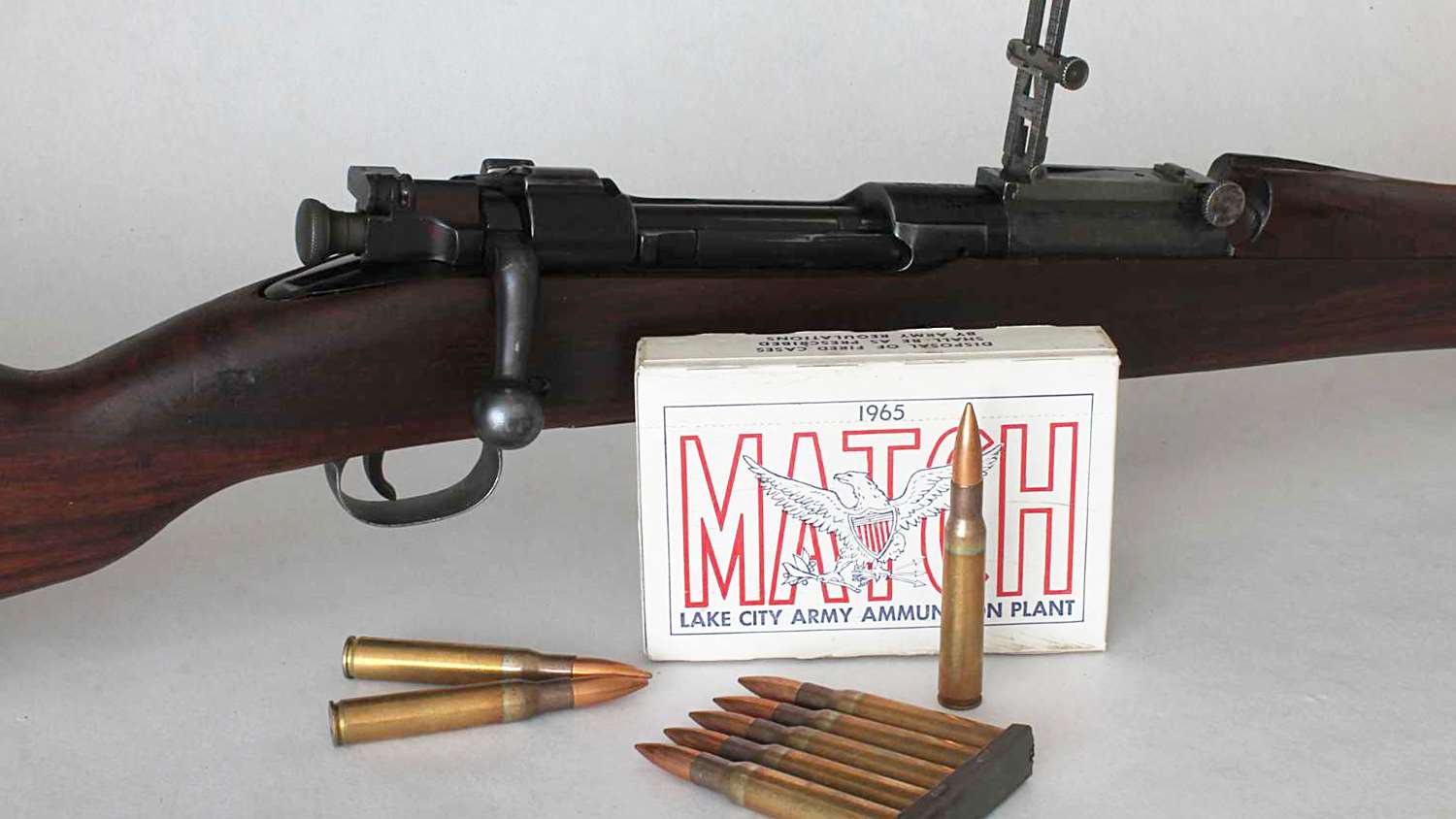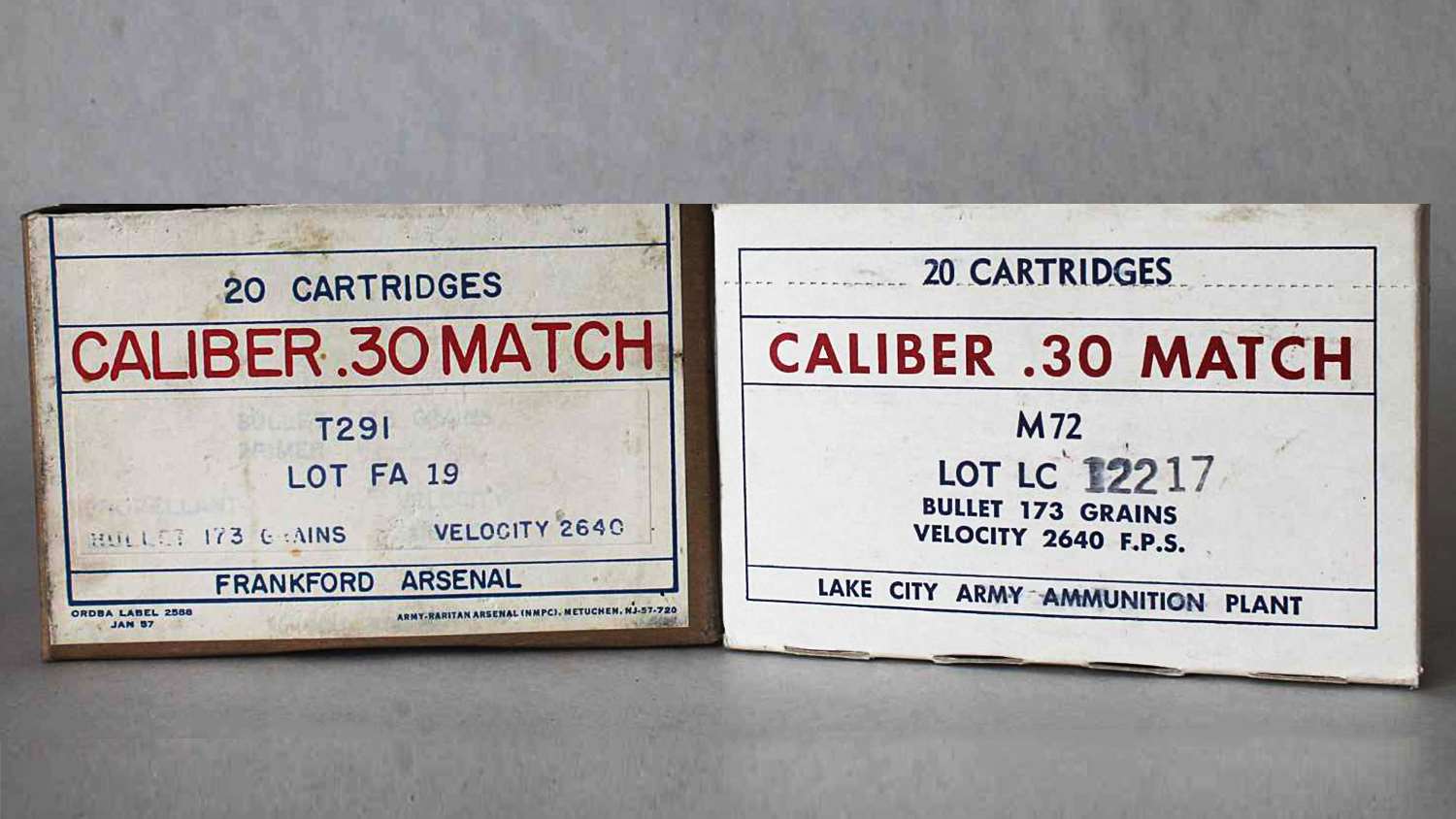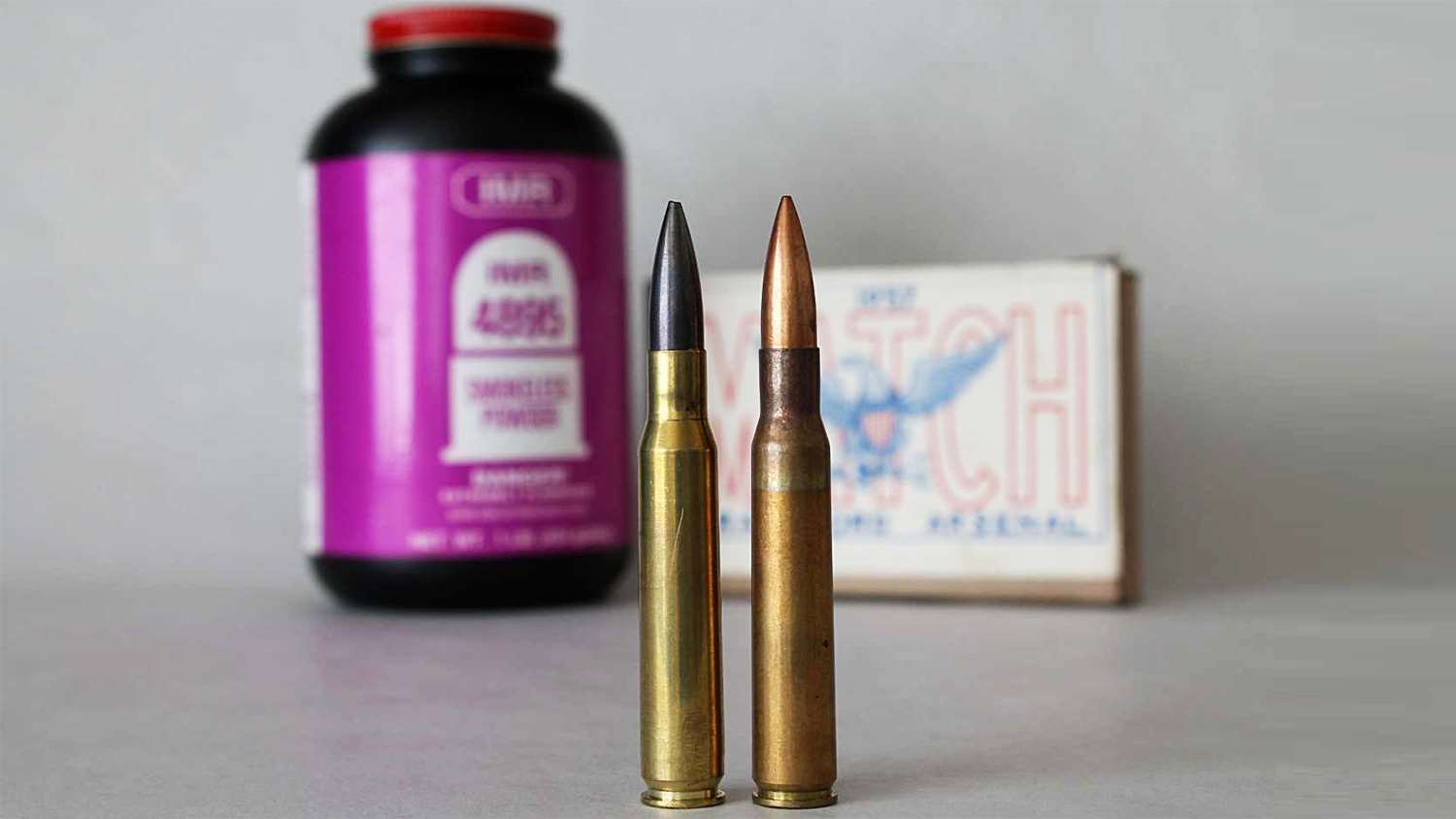** When you buy products through the links on our site, we may earn a commission that supports NRA's mission to protect, preserve and defend the Second Amendment. **

WARNING: All technical data in this publication, especially for handloading, reflect the limited experience of individuals using specific tools, products, equipment and components under specific conditions and circumstances not necessarily reported in the article and over which the National Rifle Association (NRA) has no control. The data has not otherwise been tested or verified by the NRA. The NRA, its agents, officers and employees accept no responsibility for the results obtained by persons using such data and disclaim all liability for any consequential injuries or damages.
While handloading is fun and rewarding, sometimes it just isn’t necessary to reinvent the wheel. The wheel here is the 1950s-1960s era .30-06 M72 match load that is decidedly suitable for today’s Vintage Military Rifle and Vintage Military Sniper Rifle competition. Especially with so many other handloading projects awaiting, why not just duplicate what worked so well in these same guns in the past? Here’s how.
Almost “match”
In the 1920s, Frankford Arsenal made a .30-06 match load utilizing a then-newfangled 170-grain boat tail bullet and Hi-Vel powder. One source opines that the arsenal’s 1924 batch, headstamped, “FA NM-24” was Frankford Arsenal’s most accurate production (as well as the first to bear a National Match headstamp) until the 1962 run of M72 Match. The next year, the Army switched to DuPont’s Improved Military Rifle (IMR) powders.

Either there wasn’t enough of the match ammo to go around or Frankford Arsenal dropped production because, just prior to WWII, Army “match” ammo was merely specially selected M1 Ball combat ammo, a 172- to 174-grain bullet with a muzzle velocity of 2647 fps. Post-war, when the National Matches resumed again in 1954, for the next three years “match” ammo again was simply select combat ammo, this time M2 Ball with a 150-grain bullet.

In 1957, Frankford Arsenal took up match load development again and produced the T291, which went back to using the M1 Ball’s heavier bullet. The next year the T291 designation became “Caliber .30 Match M72.” Frankford Arsenal manufactured M72 from 1958 until 1962, when match ammo production moved to the Lake City Ammunition plant. The last M72 Match apparently rolled off the line in 1967; I say “apparently” because, though several sources report 1966 as the last year of manufacture, I have a box of Lake City M72 Match dated 1967. Both Frankford Arsenal and Lake City M72 now enjoy some minor collector status, though there is still plenty of it out there, with T291 being perhaps a bit more coveted among collectors.
Recipes old and new
The M72 Match load recipe is no secret; the U.S. Army technical manual of cartridge data TM 43-0001-27 lists it as 50 grains of IMR 4895 with neither the 173-grain bullet nor primer crimped in place. What makes M72 of match grade quality is mostly in the careful assembly of components for consistent shot-to-shot performance. In the last few years of production, M72 could reportedly group just over two inches at 600 yards (I don’t know, but this was perhaps fired from Winchester Model 70 custom match rifles). A chamber pressure of 50,000 psi drives the bullet at a muzzle velocity of 2640 fps. That chamber pressure, identical to standard M2 Ball, is suitable for the M1 Garand’s gas system.
In duplicating the M72 load, the first thing we discover is a lack of 173-grain bullets. However, Sierra’s 175-grain MatchKing is a close approximation. With this bullet, the current Sierra reloading manual lists a maximum charge of 46.2 grains of IMR 4895. While that seems conservative by Army TM 43-0001-27 standards, the technical manual’s 50-grain charge is an ostensible loading; different lots of powder produced slight differences in pressure and velocity, and so charges in production M72 cartridges were actually around 48 grains of IMR 4895 and seldom, if ever, reached a full 50 grains.
A long-held axiom among reloaders is that with military brass being a bit beefier and therefore of slightly lesser internal volume than commercial brass, it’s prudent to start with loads 10 percent below those found in load data manuals. Using commercial Hornady brass makes that caution unnecessary in this exercise. Brass prep of unweighed cases consisted of cleaning, trimming, beveling flash holes and uniforming primer pockets. Federal’s 210M match primer seemed a logical choice and, indeed, ended up outperforming Winchester Large Rifle primers.

Because I had a good quantity of moly coated 175-grain SMKs on hand, I used those; I employed a Stony Point overall chamber length gauge and a bullet comparator to seat bullets .005 inch off the lands of my M1903A4 Springfield rifle, and I applied a very light crimp with a Lee factory crimp die. Sierra’s starting load with the 175-grain SMK is 42 grains of IMR 4895; beginning there and checking velocities with a chronograph, I eventually got excellent results with 46.5 grains of that powder. In my M1903A4 Vintage Military Sniper Rifle competition gun, that load turned in a best performance of a four-shot, ½ inch one-hole group with a fifth round landing slightly outside to open the group to 1.1 inches. Average bullet velocity was 2657 fps. The velocity and careful examination of fired cases show the load appears to be safe in this rifle. This well-matches the M72 match load and is more than adequate for 100- and 200-yard Vintage Military Rifle competition, as well as being competitive for 300 to 600 yard Vintage Military Sniper Rifle competition.
Maximum cartridge overall length (COAL) for the M72 is the same as for M2 Ball, 3.34 inch. Loading to this COAL helps ensure smooth feeding through M1 Garand, Springfield and M1917 rifle magazines. Stretching that COAL a bit to seat bullet ogives closer to the rifling lands for increased accuracy (precision) is appropriate when single-loading cartridges directly into the chamber, as is the practice in Vintage Military Sniper Rifle competition.
As an aside, TM 43-0001-27 lists muzzle velocities measured 78 feet from the muzzle, whereas the civilian practice today, and which I employed, is to measure 10 to 15 feet from the muzzle. It’s a safe assumption that velocities measured this close are somewhat lower another 60 feet away, dropping from 2657 fps near the muzzle to around the tech manual’s 2640 fps at 78 feet.
From 1958 to 2018
In summary, duplicating the M72 Match load with modern components isn’t difficult―indeed, it’s pretty much an exercise in classic, straight-forward handloading. The original 1958-1966 load was a 173-grain bullet launched at 2640 fps with approximately 46 to 48 grains of IMR 4895 and producing 50,000 psi. Here’s a modern recipe that produced one-inch groups at 100 yards, fired from a scoped Springfield M1903A4 rifle:
These components and this load performed well and safely in this particular rifle. Because of variables in your reloading equipment and technique, in your firearm and in your local environment, you may experience other results, including higher pressures that may be unsafe. Always start with the manufacturer’s recommended starting load listed in their reloading manual.
While handloading is fun and rewarding, sometimes it just isn’t necessary to reinvent the wheel. The wheel here is the 1950s-1960s era .30-06 M72 match load that is decidedly suitable for today’s Vintage Military Rifle and Vintage Military Sniper Rifle competition. Especially with so many other handloading projects awaiting, why not just duplicate what worked so well in these same guns in the past? Here’s how.
Almost “match”
In the 1920s, Frankford Arsenal made a .30-06 match load utilizing a then-newfangled 170-grain boat tail bullet and Hi-Vel powder. One source opines that the arsenal’s 1924 batch, headstamped, “FA NM-24” was Frankford Arsenal’s most accurate production (as well as the first to bear a National Match headstamp) until the 1962 run of M72 Match. The next year, the Army switched to DuPont’s Improved Military Rifle (IMR) powders.

Frankford Arsenal developed M72 Match specifically for the Garand and Springfield rifles. Vintage Military Rifle competitors can make their own at home.
Either there wasn’t enough of the match ammo to go around or Frankford Arsenal dropped production because, just prior to WWII, Army “match” ammo was merely specially selected M1 Ball combat ammo, a 172- to 174-grain bullet with a muzzle velocity of 2647 fps. Post-war, when the National Matches resumed again in 1954, for the next three years “match” ammo again was simply select combat ammo, this time M2 Ball with a 150-grain bullet.

The T291 of 1957 became the M72 Match round issued for National Matches.
In 1957, Frankford Arsenal took up match load development again and produced the T291, which went back to using the M1 Ball’s heavier bullet. The next year the T291 designation became “Caliber .30 Match M72.” Frankford Arsenal manufactured M72 from 1958 until 1962, when match ammo production moved to the Lake City Ammunition plant. The last M72 Match apparently rolled off the line in 1967; I say “apparently” because, though several sources report 1966 as the last year of manufacture, I have a box of Lake City M72 Match dated 1967. Both Frankford Arsenal and Lake City M72 now enjoy some minor collector status, though there is still plenty of it out there, with T291 being perhaps a bit more coveted among collectors.
Recipes old and new
The M72 Match load recipe is no secret; the U.S. Army technical manual of cartridge data TM 43-0001-27 lists it as 50 grains of IMR 4895 with neither the 173-grain bullet nor primer crimped in place. What makes M72 of match grade quality is mostly in the careful assembly of components for consistent shot-to-shot performance. In the last few years of production, M72 could reportedly group just over two inches at 600 yards (I don’t know, but this was perhaps fired from Winchester Model 70 custom match rifles). A chamber pressure of 50,000 psi drives the bullet at a muzzle velocity of 2640 fps. That chamber pressure, identical to standard M2 Ball, is suitable for the M1 Garand’s gas system.
In duplicating the M72 load, the first thing we discover is a lack of 173-grain bullets. However, Sierra’s 175-grain MatchKing is a close approximation. With this bullet, the current Sierra reloading manual lists a maximum charge of 46.2 grains of IMR 4895. While that seems conservative by Army TM 43-0001-27 standards, the technical manual’s 50-grain charge is an ostensible loading; different lots of powder produced slight differences in pressure and velocity, and so charges in production M72 cartridges were actually around 48 grains of IMR 4895 and seldom, if ever, reached a full 50 grains.
A long-held axiom among reloaders is that with military brass being a bit beefier and therefore of slightly lesser internal volume than commercial brass, it’s prudent to start with loads 10 percent below those found in load data manuals. Using commercial Hornady brass makes that caution unnecessary in this exercise. Brass prep of unweighed cases consisted of cleaning, trimming, beveling flash holes and uniforming primer pockets. Federal’s 210M match primer seemed a logical choice and, indeed, ended up outperforming Winchester Large Rifle primers.

A Sierra 175-grain MatchKing and IMR 4895 (left) duplicates the M72 Match load (right).
Because I had a good quantity of moly coated 175-grain SMKs on hand, I used those; I employed a Stony Point overall chamber length gauge and a bullet comparator to seat bullets .005 inch off the lands of my M1903A4 Springfield rifle, and I applied a very light crimp with a Lee factory crimp die. Sierra’s starting load with the 175-grain SMK is 42 grains of IMR 4895; beginning there and checking velocities with a chronograph, I eventually got excellent results with 46.5 grains of that powder. In my M1903A4 Vintage Military Sniper Rifle competition gun, that load turned in a best performance of a four-shot, ½ inch one-hole group with a fifth round landing slightly outside to open the group to 1.1 inches. Average bullet velocity was 2657 fps. The velocity and careful examination of fired cases show the load appears to be safe in this rifle. This well-matches the M72 match load and is more than adequate for 100- and 200-yard Vintage Military Rifle competition, as well as being competitive for 300 to 600 yard Vintage Military Sniper Rifle competition.
Maximum cartridge overall length (COAL) for the M72 is the same as for M2 Ball, 3.34 inch. Loading to this COAL helps ensure smooth feeding through M1 Garand, Springfield and M1917 rifle magazines. Stretching that COAL a bit to seat bullet ogives closer to the rifling lands for increased accuracy (precision) is appropriate when single-loading cartridges directly into the chamber, as is the practice in Vintage Military Sniper Rifle competition.
As an aside, TM 43-0001-27 lists muzzle velocities measured 78 feet from the muzzle, whereas the civilian practice today, and which I employed, is to measure 10 to 15 feet from the muzzle. It’s a safe assumption that velocities measured this close are somewhat lower another 60 feet away, dropping from 2657 fps near the muzzle to around the tech manual’s 2640 fps at 78 feet.
From 1958 to 2018
In summary, duplicating the M72 Match load with modern components isn’t difficult―indeed, it’s pretty much an exercise in classic, straight-forward handloading. The original 1958-1966 load was a 173-grain bullet launched at 2640 fps with approximately 46 to 48 grains of IMR 4895 and producing 50,000 psi. Here’s a modern recipe that produced one-inch groups at 100 yards, fired from a scoped Springfield M1903A4 rifle:
- Bullet: 175-grain SMK (moly’d)
- Case: Hornady
- Primer: Fed 210M
- IMR 4895: 46.5-grain
- Velocity: 2657 fps
These components and this load performed well and safely in this particular rifle. Because of variables in your reloading equipment and technique, in your firearm and in your local environment, you may experience other results, including higher pressures that may be unsafe. Always start with the manufacturer’s recommended starting load listed in their reloading manual.


































